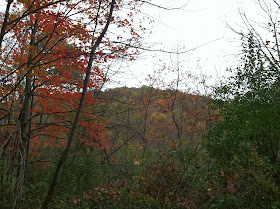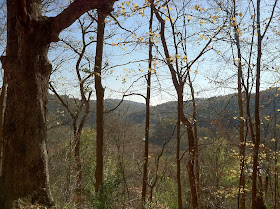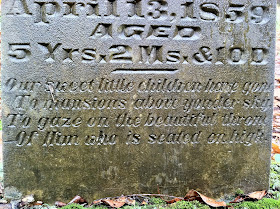Welcome, October! A weary world collapses gratefully once again into your cool embrace. Today was my third consecutive trip up to the North Country Trail to pick up my hike where I left off last time. Heading east from PA-528 (where the last trek ended) was risky. I could tell from the maps, and I knew it from the outset. The best part of the trek is a nice overlook above Lake Arthur, about half a mile in.
But then the NCT begins to meander through patches of scrappy woods, overgrown fields, and farmers' woodlots that were clearly purchased by Moraine State Park in order to move the trail from off the margins of the state highways and country roads. This is technically still state parkland, but in reality, the park is far behind you.
On the bright side, it is nice that the trail does not share space with public roads here. Unfortunately, it does run directly on the sides of roads in many--even most--places west of Moraine and McConnell's Mill, where the North Country Trail enters Ohio and the flatter, less wooded Midwestern states.
Here in the northeasternmost neck of Moraine, the park is just a bony finger of woodland between homes, and farms, and public thoroughfares. The trail crosses these small rural roads just a little too frequently for my liking. It makes me feel exposed.
This sinister quadrant of the forest is noisy with vehicles and overgrown with poison ivy and choking vines. The maples--literally every single one of them--are blighted by some fungus that makes them drop their leaves early.
I keep this blog for mainly one reason: On those occasions when I find myself stranded at my desk, stressed or bored out of my mind, fighting the urge to stick a pencil in my eye, this blog allows me to slip away to the forest (or some other scenic, historic, or forgotten place) for just a few minutes at a time. It's all about escape. I look forward to my day off all week long. But when I go to the forest, as I did today, and find the trees all blighted, it actually sends me home with less peace of mind than when I set out.
I've been to this part of the forest before. When we lived in Grove City, I found myself so desperate for a day in the woods, and the name "North Country Trail" sounded so appealing, that I came to this place to trek. I didn't like it then either, but the compulsion to continue my eastward trek along the NCT brought me back. I think I'll return to kayaking next week. These diseased trees are so depressing.








































